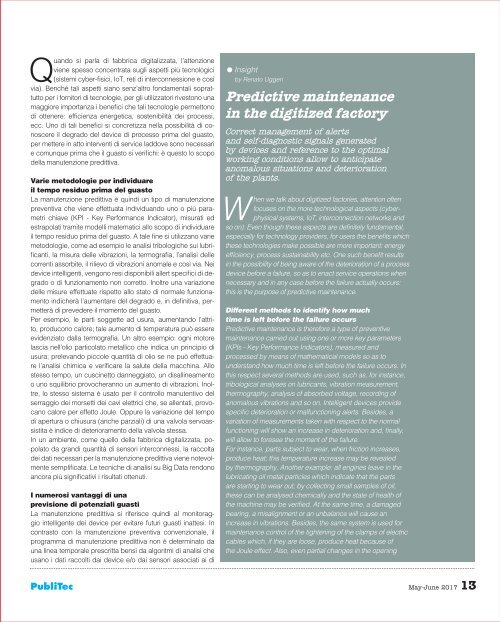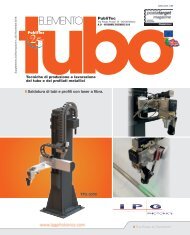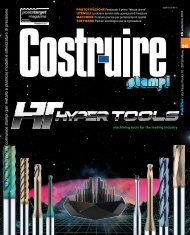CONTROLLO&MISURA_n2_MAGGIO_GIUGNO_2017
Create successful ePaper yourself
Turn your PDF publications into a flip-book with our unique Google optimized e-Paper software.
Quando si parla di fabbrica digitalizzata, l’attenzione<br />
viene spesso concentrata sugli aspetti più tecnologici<br />
(sistemi cyber-fisici, IoT, reti di interconnessione e così<br />
via). Benché tali aspetti siano senz’altro fondamentali soprattutto<br />
per i fornitori di tecnologie, per gli utilizzatori rivestono una<br />
maggiore importanza i benefici che tali tecnologie permettono<br />
di ottenere: efficienza energetica, sostenibilità dei processi,<br />
ecc. Uno di tali benefici si concretizza nella possibilità di conoscere<br />
il degrado del device di processo prima del guasto,<br />
per mettere in atto interventi di service laddove sono necessari<br />
e comunque prima che il guasto si verifichi: è questo lo scopo<br />
della manutenzione predittiva.<br />
Varie metodologie per individuare<br />
il tempo residuo prima del guasto<br />
La manutenzione predittiva è quindi un tipo di manutenzione<br />
preventiva che viene effettuata individuando uno o più parametri<br />
chiave (KPI - Key Performance Indicator), misurati ed<br />
estrapolati tramite modelli matematici allo scopo di individuare<br />
il tempo residuo prima del guasto. A tale fine si utilizzano varie<br />
metodologie, come ad esempio le analisi tribologiche sui lubrificanti,<br />
la misura delle vibrazioni, la termografia, l’analisi delle<br />
correnti assorbite, il rilievo di vibrazioni anomale e così via. Nei<br />
device intelligenti, vengono resi disponibili allert specifici di degrado<br />
o di funzionamento non corretto. Inoltre una variazione<br />
delle misure effettuate rispetto allo stato di normale funzionamento<br />
indicherà l’aumentare del degrado e, in definitiva, permetterà<br />
di prevedere il momento del guasto.<br />
Per esempio, le parti soggette ad usura, aumentando l’attrito,<br />
producono calore; tale aumento di temperatura può essere<br />
evidenziato dalla termografia. Un altro esempio: ogni motore<br />
lascia nell’olio particolato metallico che indica un principio di<br />
usura; prelevando piccole quantità di olio se ne può effettuare<br />
l’analisi chimica e verificare la salute della macchina. Allo<br />
stesso tempo, un cuscinetto danneggiato, un disallineamento<br />
o uno squilibrio provocheranno un aumento di vibrazioni. Inoltre,<br />
lo stesso sistema è usato per il controllo manutentivo del<br />
serraggio dei morsetti dei cavi elettrici che, se allentati, provocano<br />
calore per effetto Joule. Oppure la variazione del tempo<br />
di apertura o chiusura (anche parziali) di una valvola servoassistita<br />
è indice di deterioramento della valvola stessa.<br />
In un ambiente, come quello della fabbrica digitalizzata, popolato<br />
da grandi quantità di sensori interconnessi, la raccolta<br />
dei dati necessari per la manutenzione predittiva viene notevolmente<br />
semplificata. Le tecniche di analisi su Big Data rendono<br />
ancora più significativi i risultati ottenuti.<br />
I numerosi vantaggi di una<br />
previsione di potenziali guasti<br />
La manutenzione predittiva si riferisce quindi al monitoraggio<br />
intelligente dei device per evitare futuri guasti inattesi. In<br />
contrasto con la manutenzione preventiva convenzionale, il<br />
programma di manutenzione predittiva non è determinato da<br />
una linea temporale prescritta bensì da algoritmi di analisi che<br />
usano i dati raccolti dai device e/o dai sensori associati ai di<br />
l Insight<br />
by Renato Uggeri<br />
Predictive maintenance<br />
in the digitized factory<br />
Correct management of alerts<br />
and self-diagnostic signals generated<br />
by devices and reference to the optimal<br />
working conditions allow to anticipate<br />
anomalous situations and deterioration<br />
of the plants.<br />
W<br />
hen we talk about digitized factories, attention often<br />
focuses on the more technological aspects (cyberphysical<br />
systems, IoT, interconnection networks and<br />
so on). Even though these aspects are definitely fundamental,<br />
especially for technology providers, for users the benefits which<br />
these technologies make possible are more important: energy<br />
efficiency, process sustainability etc. One such benefit results<br />
in the possibility of being aware of the deterioration of a process<br />
device before a failure, so as to enact service operations when<br />
necessary and in any case before the failure actually occurs:<br />
this is the purpose of predictive maintenance.<br />
Different methods to identify how much<br />
time is left before the failure occurs<br />
Predictive maintenance is therefore a type of preventive<br />
maintenance carried out using one or more key parameters<br />
(KPIs - Key Performance Indicators), measured and<br />
processed by means of mathematical models so as to<br />
understand how much time is left before the failure occurs. In<br />
this respect several methods are used, such as, for instance,<br />
tribological analyses on lubricants, vibration measurement,<br />
thermography, analysis of absorbed voltage, recording of<br />
anomalous vibrations and so on. Intelligent devices provide<br />
specific deterioration or malfunctioning alerts. Besides, a<br />
variation of measurements taken with respect to the normal<br />
functioning will show an increase in deterioration and, finally,<br />
will allow to foresee the moment of the failure.<br />
For instance, parts subject to wear, when friction increases,<br />
produce heat; this temperature increase may be revealed<br />
by thermography. Another ex<strong>amp</strong>le: all engines leave in the<br />
lubricating oil metal particles which indicate that the parts<br />
are starting to wear out; by collecting small s<strong>amp</strong>les of oil,<br />
these can be analysed chemically and the state of health of<br />
the machine may be verified. At the same time, a damaged<br />
bearing, a misalignment or an unbalance will cause an<br />
increase in vibrations. Besides, the same system is used for<br />
maintenance control of the tightening of the cl<strong>amp</strong>s of electric<br />
cables which, if they are loose, produce heat because of<br />
the Joule effect. Also, even partial changes in the opening<br />
PubliTec May-June <strong>2017</strong> 13





